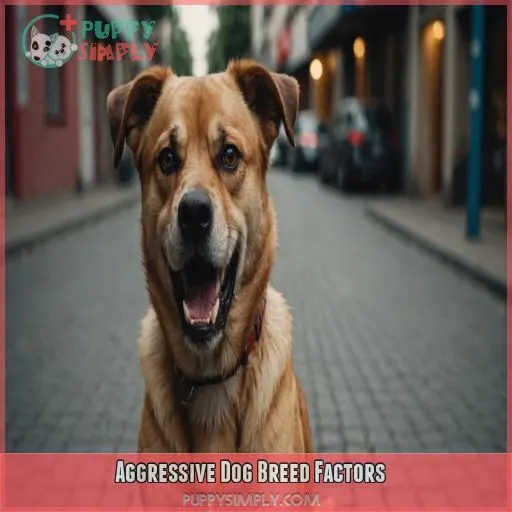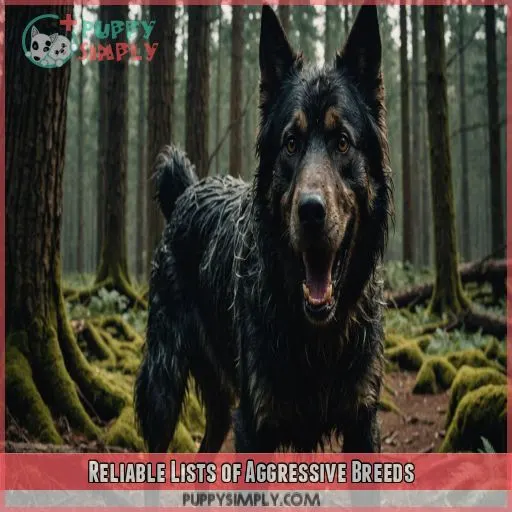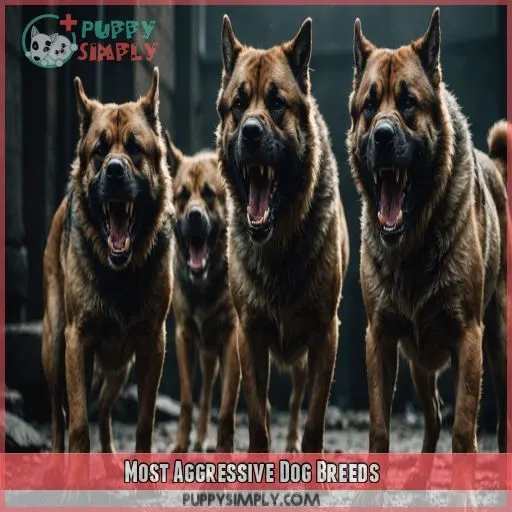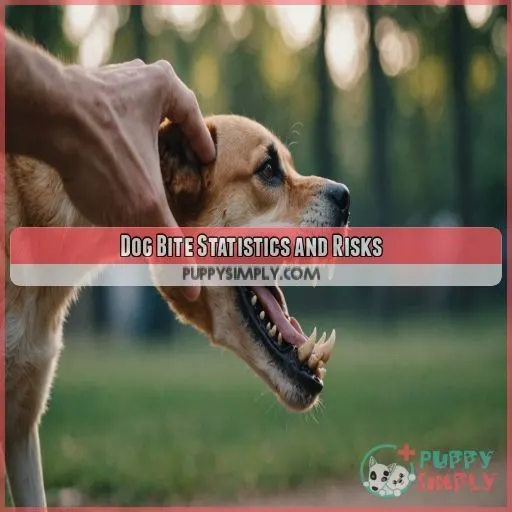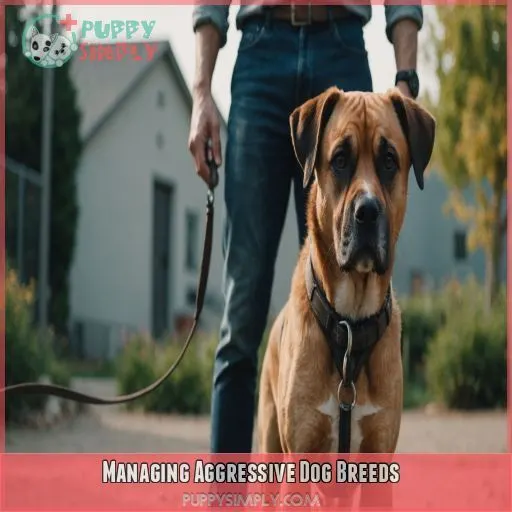This site is supported by our readers. We may earn a commission, at no cost to you, if you purchase through links.
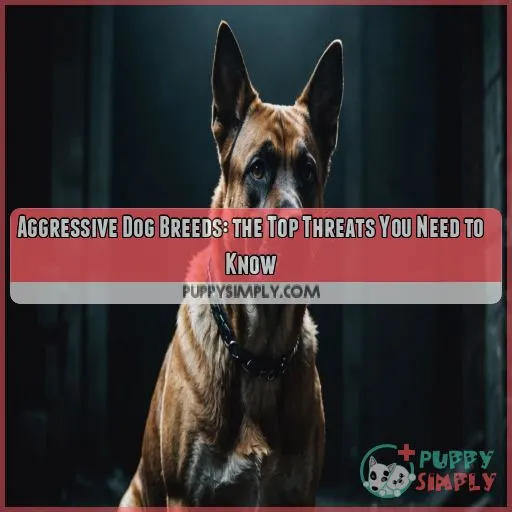 Aggressive dog breeds can be a real handful, but with the right know-how, you can turn potential chaos into calm.
Aggressive dog breeds can be a real handful, but with the right know-how, you can turn potential chaos into calm.
From feisty Chihuahuas to powerful Rottweilers, certain breeds are prone to territorial tendencies and unpredictable behavior.
But don’t let that scare you off – proper training, socialization, and responsible ownership are key to managing these canine characters.
Stay on top of their exercise needs, curb any biting or growling early on, and you’ll have a loyal, well-behaved companion.
Just remember, every dog is unique, so get to know your pup’s personality and adapt your approach accordingly.
Taming an aggressive breed is all about finding that sweet spot between control and companionship.
Table Of Contents
- Key Takeaways
- Aggressive Dog Breed Factors
- Reliable Lists of Aggressive Breeds
- Most Aggressive Dog Breeds
- Chihuahua – Small but Fierce
- Rottweiler – Loyal and Powerful
- Pitbull Terrier – Strong and Muscular
- Neapolitan Mastiff – Fiercely Loyal and Protective
- Presa Canario – Territorial and Distrustful
- American Bulldog – Powerful and Muscular
- Bullmastiff – Alert, Fearless, and Devoted
- Siberian Husky – Strong Survival Instincts
- Dog Bite Statistics and Risks
- Managing Aggressive Dog Breeds
- Frequently Asked Questions (FAQs)
- What is the number one aggressive dog breed?
- Are any dog breeds naturally aggressive?
- What is the least aggressive dog?
- How to deal with an aggressive dog?
- How does diet influence canine aggression?
- What role does genetics play in aggression mitigation?
- Can spaying or neutering reduce aggression in dogs?
- How do dog shelters assess aggressive behavior?
- What are the legal implications of owning an aggressive breed?
- Conclusion
Key Takeaways
- Understand that certain dog breeds have a genetic predisposition to aggression, but proper training, socialization, and responsible ownership can turn even the toughest pups into loyal companions. It’s all about finding that sweet spot between control and companionship.
- Manage aggressive breeds proactively by providing ample exercise, mental stimulation, and early training. Nip any concerning behaviors in the bud before they become ingrained. Remember, a tired dog is a calm dog.
- As an owner of an aggressive breed, you’re accountable for your pup’s actions. Be a responsible pet parent by brushing up on local laws, educating the public, and setting your furry friend up for success through diligent training.
- Don’t let stereotypes or media bias sway you – every dog is unique. With the right approach, even the most misunderstood breeds, such as the Japanese Tosa or wolf-dog hybrids, can be as gentle as a lamb. It’s all about finding the right fit for your lifestyle.
Aggressive Dog Breed Factors
When you’re choosing a dog breed, it’s important to know that genetics, size, and training can all influence whether a dog might be aggressive. Just like some people get grumpy without their morning coffee, dogs can act out if they’re bored or anxious, making environment and behavior a big piece of the puzzle.
Genetics and Prey Drive
Genetics and a dog’s natural prey drive can predispose certain breeds to aggression. After all, some pups were selectively bred for guarding, hunting, or even fighting – traits that can translate to hostile behavior. You’ll want to research a breed’s origins to understand its potential for aggression:
- Herding dogs may have a higher prey drive
- Guard dogs may be more territorial and protective
- Fighting breeds may be more prone to unprovoked attacks
Strength, Size, and Trainability
Let’s talk size and strength. Some breeds, like Rottweilers, pack a punch in both departments. They’re the linebacker of dogs! But without proper dog training and experience, managing such breeds can be like juggling firecrackers. Their strength demands respect. Training is non-negotiable—turn potential chaos into well-behaved canine citizens. It’s all about harnessing power responsibly!
Behavioral Issues and Environmental Factors
After understanding their strength and trainability, remember that behavioral issues can turn dogs into ticking time bombs. Imagine a frustrated office worker snapping after a bad day—dogs feel the same! An unsocialized pup, much like an out-of-control toddler, may react unexpectedly. Healthy dog environments prevent aggression—think of it as maintaining peace at a crowded family dinner.
Boredom, Anxiety, Fear, and Stress Triggers
Having managed those environmental factors, remember: dogs can get stressed or anxious, too.
A bored Doberman Pinscher might chew your favorite shoes, and a stressed Chow Chow could become irritable.
American Bulldogs and German Shepherds can also face anxiety and fear.
Keep them entertained! Engage their minds like you’d solve a Rubik’s Cube; frustration should never be the trigger for aggression.
Reliable Lists of Aggressive Breeds
If you’re trying to figure out which dog breeds are aggressive, it’s easy to get caught up in what people say or old stories about ferocious furry friends, but understanding protective aggression can help you make better decisions.
. Instead, focus on fact-based insights, like a breed’s original purpose, ensuring you’re not barking up the wrong tree!
Public Opinion Vs. Fact-Based Lists
It’s easy to get tangled in breed stereotypes fueled by media hype.
Responsible breeding and data accuracy play huge roles.
Owner bias can skew perceptions of "dangerous dogs."
Instead, use fact-based lists for choosing suitable dog breeds for families and beginners.
Even the misunderstood Japanese Tosa has its own charm!
Breeding History and Original Purpose
When deciding on a dog breed, remember their breeding history. Many were bred as working dogs, with traits like guarding instincts, hunting heritage, or being fighting dogs. Think of a Dogo Argentino or an Alaskan Malamute—both protective and strong. Whether it’s a Japanese Tosa or a Siberian Husky, their past roles influence behavior. Stay informed and safe!
ATTS Testing and Temperament Evaluation
The American Temperament Test Society (ATTS) can help gauge a breed’s temperament, but don’t take their results as gospel. These tests have limitations – they’re breed-specific, and individual dogs may still surprise you. With aggressive breeds like the Japanese Tosa, always err on the side of caution and get an experienced owner’s input.
Individual Differences and Breed Variability
You know what they say: every dog is unique!
While breed stereotypes exist, individual temperament trumps all.
Even a Japanese Tosa or a wolf-dog hybrid can be as gentle as a lamb with the right environment.
The key? Socialization methods suited to their needs.
Responsible Ownership and Mitigating Aggression
Being a responsible dog owner is like steering a ship—early intervention and navigation matter. Use effective training methods and socialization tips: think of dog parks as social mixers. Manage stress like a seasoned therapist. Choose dog breeds for family, children, seniors, or apartments wisely. Big or small, every dog needs a captain for smooth sailing!
Most Aggressive Dog Breeds
You might think small dogs like Chihuahuas are safe, but even they can pack quite a bite! From loyal Rottweilers to muscular Pitbull Terriers, learn about the most aggressive dog breeds and why they need careful handling.
Chihuahua – Small but Fierce
Don’t let their small stature fool you – Chihuahuas can pack a serious punch in regard to aggression. These feisty pups are known for their fierce territorial nature and distrust of strangers. But with proper training and socialization from an early age, you can curb those fiery tendencies and turn your Chihuahua into a loyal, loving companion.
Rottweiler – Loyal and Powerful
Rottweilers are your loyal, powerful companionsa force to reckon with! Known for their protective nature, they make ideal guard dogs. But don’t let their size fool you; with proper Rottweiler training and care, they thrive. Originating as cattle herders, they adapt well to both country and suburban life. Rottweiler temperament requires socialization to make sure a calm demeanor.
Pitbull Terrier – Strong and Muscular
After exploring how Rottweilers blend loyalty with power, let’s talk about Pitbull Terriers. With their muscular, strong build, Pitbulls often get a bad rap due to myths and headlines. However, their temperament is shaped largely by history and training. For life in the city or suburbs, focus on socialization and structured training to bring out their gentle side.
Neapolitan Mastiff – Fiercely Loyal and Protective
The Neapolitan Mastiff is a force to be reckoned with – fiercely loyal to their family, but highly suspicious of strangers. These massive pups pack a powerful punch, with jaws that can deliver a bone-crushing bite. If you’re up for the challenge, proper training and socialization are a must to manage their protective instincts.
Presa Canario – Territorial and Distrustful
Meet the Presa Canarioa breed with a tough guy reputation. Known for their territorial nature and distrust of strangers, it’s critical that you provide proper Presa Canario training and socialization. Their history as guard dogs means they’re naturally protective. As an owner, taking responsibility for their behavior helps create a harmonious life. Think of them as furry bouncers!
American Bulldog – Powerful and Muscular
The American Bulldog is more than just muscle; it’s a bundle of strength and tenacity.
With proper training, they’re as loyal as an old friend.
Keep their health in check with regular vet visits.
With love and oversight, their powerful presence is a charm, not a challenge.
Bullmastiff – Alert, Fearless, and Devoted
Bullmastiffs might look like couch potatoes, but don’t let that fool you. These dogs are alert, fearless, and completely devoted to their families. Imagining them as gentle giants? Well, training is key. Without it, their strength can be overwhelming. They’ll happily lounge around, but be ready to manage bullmastiff temperament proactively. Consistent bullmastiff care helps them stay loyal companions.
Siberian Husky – Strong Survival Instincts
With their strong survival instincts, Siberian Huskies can be a handful. These energetic pups were bred for sledding, so they crave an active lifestyle. To tame their independent spirit, you’ll need to:
- Provide ample exercise and mental stimulation
- Establish yourself as the pack leader
- Secure your home, as Huskies are escape artists
- Socialize them early and often
- Consider their sledding heritage when training
Dog Bite Statistics and Risks
Regarding dog bites, knowing the statistics can save your skin—literally! You’ll be shocked to learn how often these incidents occur and which breeds pack the biggest punch.
Annual Dog Bite Incidents and Fatalities
Dog breeds can be entertaining companions or sudden alarm bells! According to dog bite statistics, over 4.5 million Americans are bitten each year. Here’s the harsh reality:
| Statistic | Detail |
|---|---|
| Total bites |
4.5 million yearly
Stay safe, and always keep a leash on both your pup and your safety awareness!
Pit Bulls – Highest Number of Fatal Attacks
When considering the Pit Bull breed standards, it’s important to understand their media portrayal often overshadows reality Pit Bull Breed Characteristics.
. They’ve a strong bite force, and with that comes certain legal implications. Make sure you’re a safe and responsible owner by:
- Providing early socialization
- Engaging in regular training
- Offering plenty of exercise
- Maintaining a stable environment
- Seeking professional help if needed
Rottweilers – Protective Nature and High Bite Force
Rottweilers are known for their protective nature and powerful bite force, boasting a jaw-dropping 328 PSI bite force comparison.
. While these loyal companions make excellent guard dogs, their strength requires experienced handling. Proper training and socialization are a must to manage Rottweiler aggression. As with any breed, responsible ownership is key to keeping both your Rottie and others safe.
| Rottweiler Traits | Bite Force | Breed History |
|---|---|---|
| Protective | 328 PSI | Originally used as guard dogs in Germany |
| Loyal | High | Bred for strength and guarding abilities |
German Shepherds – Aggressive and Territorial
German Shepherds are like vigilant sentinels, guarding with loyalty and an edge of territorial instinct. Though their strong temperament inspires confidence, it can also make them a handful if not properly trained. Focus on diligent training and socialization, ensuring your shepherd doesn’t bark up the wrong tree. Remember, owner responsibility is pivotal in taming these noble yet spirited companions.
American Bulldogs – Powerful and Muscular Build
Continuing from the traits of German Shepherds, let’s focus on American Bulldogs, a breed known for loyalty.
. These fellows are powerhouses—built like tanks! With a strong and muscular build, they need consistent training and socialization. Don’t underestimate their exercise needs, either. Without enough playtime, they might chew through your couch! Treat their temperament with respect, and you’ll have a loyal companion.
Bullmastiffs – High Bite Force and Devotion to Family
So, you’ve conquered the American Bulldog’s challenges. Now meet the Bullmastiff: a powerhouse with a jaw that packs a punch and a heart as big as a house. Their devotion to family can’t be beat, but remember—training and socialization are non-negotiable. If you’re not prepared, even your postman might wish he’d chosen another route!
Managing Aggressive Dog Breeds
Managing aggressive dog breeds requires diligence and a little bit of patience, like teaching a toddler not to color on the walls. You must prioritize early training and socialization to make sure your furry friend doesn’t mistake the mailman for a chew toy.
Early Training and Socialization
Consistently enrolling your pup in puppy classes and using positive reinforcement training is key to managing aggressive tendencies puppy aggression types.
.
Socialize them early and often – let them experience new sights, sounds, and people in a controlled, rewarding way.
Nip any biting or growling in the bud with patience and gentle redirection.
With the right approach, you can curb concerning behaviors before they become ingrained.
Male Dogs – Higher Risk of Aggression
When managing aggressive dog breeds, male dogs can often bring an extra sprinkle of zest—sometimes too much! Due to hormonal influences, males might exhibit:
- Testosterone levels-driven assertiveness
- Social dominance behaviors
- Intriguing breeding practices
To help curb this energetic enthusiasm, consider training and socialization. It’s like handing them the keys to maturity… minus the midlife crisis!
Unneutered/Unspayed Dogs – Territorial and Aggressive
Unneutered or unspayed dogs tend to be more territorial and aggressive. Their hormonal influences can trigger possessive behaviors, making them more likely to lash out and defend their turf. spaying or neutering your pup is a responsible choice that can help curb these aggressive tendencies and keep everyone safe. It’s a small step that goes a long way!
Fence Aggression and Defending Territory
Does Fido go nuts when the neighbor’s cat walks by? You’re witnessing fence aggression—a dog’s way of defending their turf. Think of it as canine border patrol.
- Consider barriers: Solid fences can prevent visual triggers.
- Command control: Reinforce commands to redirect attention.
- Encourage exercise: A tired dog is a calm dog.
With training, you’ll turn chaos into calm.
Never Approach an Unfamiliar Dog
Approaching an unfamiliar dog is like playing with fire—best avoided! Safety tips to heed include reading dog body language and respecting leash laws. Remember, stranger danger applies to dogs too. Even the friendliest-looking pooch mightn’t welcome a surprise. Stay safe, give them space, and listen to their signals.
| Dog Signals | What it Means | Your Action |
|---|---|---|
| Tail Tucked | Fear or stress | Back away slowly |
| Growling | Warning sign | Keep distance |
| Relaxed Tail | Comfortable | Approach cautiously |
Responsible Ownership and Public Perception
Owning an aggressive breed means being a responsible pet parent.
You are accountable for your pup’s actions.
Brush up on dog park etiquette and local breed-specific laws.
Educate the public – don’t let media bias sway you.
With proper training and socialization, you can manage even the toughest breeds.
It’s all about setting your dog up for success.
Frequently Asked Questions (FAQs)
What is the number one aggressive dog breed?
If you’re looking for a powerhouse, the American Pit Bull Terrier often tops the list for aggression. Remember, proper training and socialization can turn these strong-willed pups into loyal companions, not neighborhood bullies.
Are any dog breeds naturally aggressive?
Some dog breeds have been bred with a high prey drive or guarding instincts, which can make them seem naturally aggressive. However, individual temperament and behavior depends on training, socialization, and how they’re handled by their owners.
What is the least aggressive dog?
Isn’t it ironic? The big, sometimes intimidating Labrador Retriever is actually one of the least aggressive dog breeds out there. They’re like the friendly giants of the dog world, always keen to please and incredibly gentle.
How to deal with an aggressive dog?
Dealing with an aggressive dog can be challenging.
? Stay calm and assertive. Use firm commands to regain control, and never show fear. Consider professional training, early socialization, and consistent routines. Remember, patience and understanding can work wonders in taming tempers.
How does diet influence canine aggression?
Did you know poor diet can spike aggression in pups, much like a bad mood from an empty stomach? Make sure Rover gets balanced meals, or you might find yourself dealing with a hangry hound causing a whirlwind!
What role does genetics play in aggression mitigation?
Genetics can shape a dog’s propensity for aggression, but don’t let that spook you. Thoughtful breeding and selection can reduce these tendencies. Remember, it’s a dance between nature and nurture to achieve a harmonious behavior.
Can spaying or neutering reduce aggression in dogs?
Spaying or neutering curbs aggression by reducing hormone-driven behaviors. It’s like putting a lid on a boiling pot—calmer dogs mean safer environments. You’ll gain more control, ensuring your furry friend behaves like the good dog they are!
How do dog shelters assess aggressive behavior?
In shelters, figuring out a dog’s behavior requires careful observation, temperament tests, and history checks. Think of it like a dog’s job interview; they’re evaluated on reactions to people, other animals, and various situations to gauge aggression.
What are the legal implications of owning an aggressive breed?
Owning an aggressive breed can be like walking a tightrope without a net. You must navigate local laws, potential liabilities, homeowner’s insurance restrictions, and breed bans, making responsible training and safety measures essential to avoid legal trouble.
Conclusion
Picture yourself as a knight in shining armor, ready to tackle the dragon of aggressive dog breeds.
With knowledge, patience, and the right approach, you can transform any beast into a loyal friend.
While challenges are inevitable, they are nothing compared to the fierce companionship you will develop.
Embrace responsible ownership, stay informed, and enjoy a rewarding bond with your furry protector.

